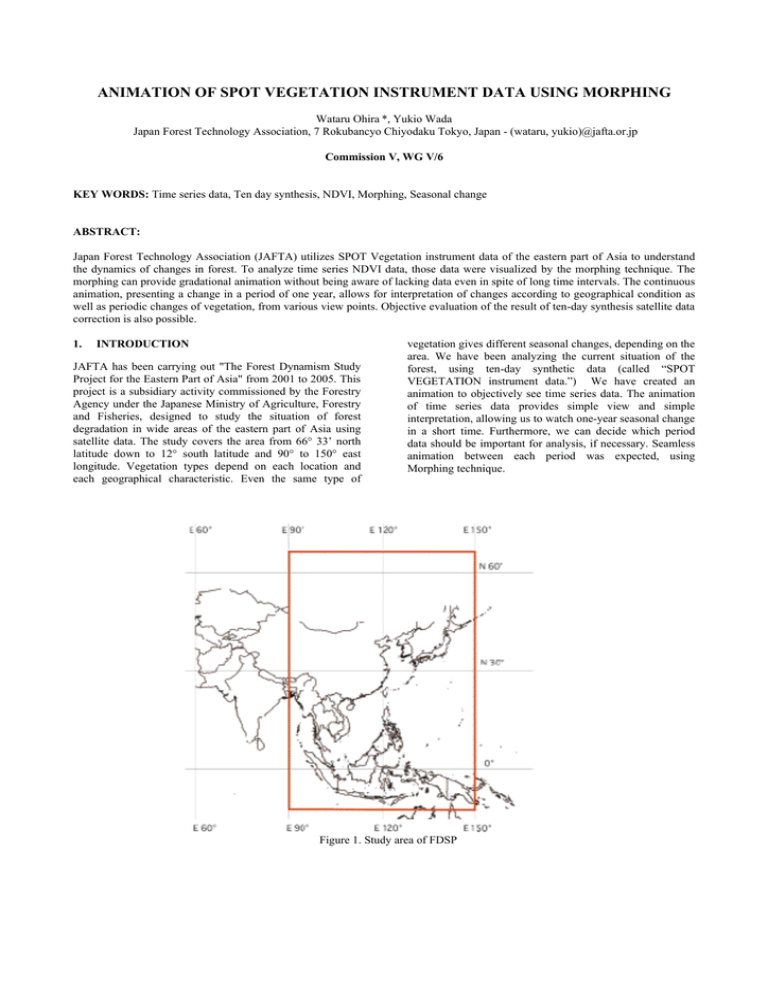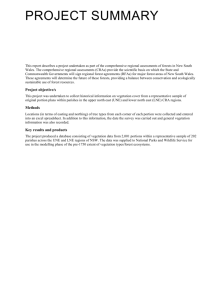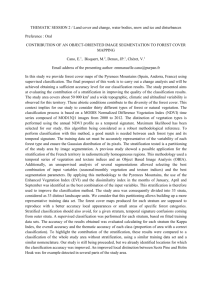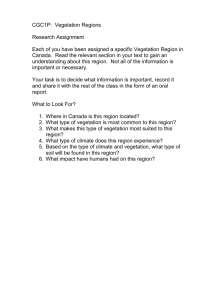ANIMATION OF SPOT VEGETATION INSTRUMENT DATA USING MORPHING
advertisement

ANIMATION OF SPOT VEGETATION INSTRUMENT DATA USING MORPHING Wataru Ohira *, Yukio Wada Japan Forest Technology Association, 7 Rokubancyo Chiyodaku Tokyo, Japan - (wataru, yukio)@jafta.or.jp Commission V, WG V/6 KEY WORDS: Time series data, Ten day synthesis, NDVI, Morphing, Seasonal change ABSTRACT: Japan Forest Technology Association (JAFTA) utilizes SPOT Vegetation instrument data of the eastern part of Asia to understand the dynamics of changes in forest. To analyze time series NDVI data, those data were visualized by the morphing technique. The morphing can provide gradational animation without being aware of lacking data even in spite of long time intervals. The continuous animation, presenting a change in a period of one year, allows for interpretation of changes according to geographical condition as well as periodic changes of vegetation, from various view points. Objective evaluation of the result of ten-day synthesis satellite data correction is also possible. 1. INTRODUCTION JAFTA has been carrying out "The Forest Dynamism Study Project for the Eastern Part of Asia" from 2001 to 2005. This project is a subsidiary activity commissioned by the Forestry Agency under the Japanese Ministry of Agriculture, Forestry and Fisheries, designed to study the situation of forest degradation in wide areas of the eastern part of Asia using satellite data. The study covers the area from 66° 33’ north latitude down to 12° south latitude and 90° to 150° east longitude. Vegetation types depend on each location and each geographical characteristic. Even the same type of vegetation gives different seasonal changes, depending on the area. We have been analyzing the current situation of the forest, using ten-day synthetic data (called “SPOT VEGETATION instrument data.”) We have created an animation to objectively see time series data. The animation of time series data provides simple view and simple interpretation, allowing us to watch one-year seasonal change in a short time. Furthermore, we can decide which period data should be important for analysis, if necessary. Seamless animation between each period was expected, using Morphing technique. Figure 1. Study area of FDSP 2. SPOT DATA VEGETATION INSTRUMENT The necessity of analysis was considered not only to the data obtained in a series of time but also to that obtained at one time. Actually, reducing the cloud influence was greatly expected. As a result, SPOT Vegetation instrument data was selected because of the necessity of frequent observations and ease of data acquisition. The SPOT 4, currently in operation, is orbiting the earth at an altitude of 832 km, in a 26-day cycle. The SPOT 4 loads two kinds of sensors: Haute Resolution Visible Infra-Red (HRVIR) instrument and VEGETATION instrument, allowing the daily observation of 2,250 km in swash width with a resolution of 1.15 km for almost all the area, excluding some parts around the equator. And the VEGETATION instrument covers almost all of the globe's landmasses every day. To save data volume, ten-day synthesis data was utilized. Observed data from October 1998 to March 2001 was acquired. The advantage of the ten-day synthesis data was that the highest signal data within the ten-day observation was employed as a pixel value for the ten-day synthesis data; therefore, the cloud cover influences are favorably reduced. But we wanted to pursuit cloudless data, and made corrections for ten-day synthesis data. Local Maximum Fitting (LMF) was executed for the correction. 3. MORPHING Morphing comes from "metamorphosing,” indicating an ability of the computer which calculates plural frame to draw between two different “key” frames. Morphing is able to insert many intermediate frames between a pair of key frames, allowing the creation of an animation faster than handwork. The first motivation to make an animation was not to create the movie itself but to watch the change of a year. It was not wise to spend a lot of time and effort for making an animation. The ten-day synthesis satellite data consists of 36 files for one year. Not all of them were needed for creating the animation. We chose one frame per month, escaping from a huge operation. Morphing was expected to provide a smooth change between key frames. Satellite image morphing does not need to change the image shape, resulting in no settings for control-line or control-point; therefore, Morphing effects only color change. 4. SEASONAL CHANGE NDVI (Normalized Difference Vegetation Index) is an index which shows leaves volume on the surface, utilizing reflection and absorption of chlorophyll characteristics in plants. We can recognize distribution or condition of vegetation from it. The animation, using time series data, can show the seasonal change of vegetation. Indochina Peninsula The change of NDVI throughout the year shows that the monsoon forest of in tropical regions influenced by the monsoon, specifically in the Indochina Peninsula, fluctuates in the NDVI value between the rainy and dry seasons. This is because plants grow actively on good water conditions but inactive on poor water conditions. Therefore, we can think that NDVI keeps on high value in the rainy season and low value in the dry season. Actually, the high peak of NDVI is shown from the end of the rainy season to the beginning of the dry season. And the NDVI does not drop immediately after the dry season starts, but falls slowly. The lowest peak of NDVI is shown at the beginning of the rainy season and NDVI suddenly rises at the end of the rainy season. We guess this type of forest feels physiological water stress slowly and does not recover soon in the dry season. It seems that NDVI is measured low in the rainy season because of rain, cloud, and other atmospheric conditions. Since performing comparison reduces this effect, it is conceivable that plants are inactive under less sunshine conditions, and plants become active all at once from the end of the rainy season, with a lot of sunshine, to the beginning of the dry season. Tropical Forest It is conceivable that no fluctuation of NDVI is present on a tropical evergreen forest near the equator throughout the year. But a little fluctuation is shown there, indicating high peak of NDVI in the period from the end of the rainy season to the beginning of the dry season and relatively low during the rainy season. Figure 2. NDVI image / Oct. 21-30, 2000 Warm-Temperate Forest It is clearly seen that the NDVI of Japan, in the temperate zone with four seasons, starts to increase from the beginning of spring and gradually decreases from autumn to winter. In addition, it is seen that the NDVI of China gradually increases from south to north and toward interior as the season advances, and double-cropping seems to be underway in some areas. Frigid Forest It has been seen that the vegetation begins to appear, surrounding the Gobi Desert in a short period of time during the summer in the frigid forest. Table or graph may be used just for showing changes of NDVI. Watching the animation leads us to comprehensively understand “when,” “where,” and “how” it changes. In addition, as mentioned above, animation allows us to assume events occurring at that area for interpretation. For verifying the fact, a field investigation is required as required in addition to in-depth information and related materials. 5. EVALUATION OF CORRECTION The satellite image data collected in wide areas shows different spectral intensities even for the same covertures over the surface, depending on the conditions of cloud and atmosphere and the incident angle of sunlight. The ten-day synthesis data includes complex involvement in these relationships. Filtering processing was conducted to the data to reduce the influence. This method can correct the signal intensity value, which was measured lower due to the effect caused by cloud or the like, to the expected original value, on the assumption that the occurrence of vegetation change in particular, as one of the covertures, repeats at a constant cycle. Several methods are now proposed for handling time series data. Animation can provide objective judgment from the result of this processing. At this time, we have conducted the Local Maximum Fitting (LMF) processing, designed by the Forestry and Forest Products Research Institute under the Japanese Ministry of Agriculture, Forestry and Fisheries, comparing its processed data with the original one. The processed data generally shows a natural seasonal change of vegetation, particularly providing effective correction in the data of tropical regions, frequently covered with clouds. There may be, however, the possibility to fail to completely get rid of the impact caused by the signal intensity drop or small value fluctuation during the rainy season 6. CONCLUSION What we are pursuing is to understand the trend of forests. We, therefore, conduct analysis using time series data. The animation of the SPOT VEGETATION Instrument NDVI data provides visual presentation of vegetation change along with the changing seasons. This also provides us with important information for making decision of the significant time of the year. It is also possible to select either all the data or effective data combination for the analysis. The animation, in fact, excites imagination and intellectual curiosity of data analyzers, narrowing down important points at the time of conducting a field study at site. Combined image with other bandwidths or animation using data in different resolutions will surely provide us with much different visual information. 7. REFERENCES Mark E. Jakubauskas, David R. Legates, and Jude H. Kastens, 2001. Harmonic analysis of time-series AVHRR NDVI data. Photogrammetric Engineering & Remote Sensing Vol. 67, No.4, pp. 461-470 Scott Anderson, 1993. Morphing Magic. Sams Publishing, USA SPOTSYSTEM, http://www.spotimage.fr/home/system/introsat/payload/veget ati/welcome.htm (accessed 22 Jan. 17)



